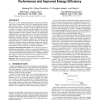128
click to vote
CODES
2004
IEEE
15 years 4 months ago
2004
IEEE
In this paper, a novel method for high-level specification and validation of SoC designs using UML is proposed. UML is introduced as a formal model of specification for SoC design...
103
Voted
CODES
2004
IEEE
15 years 4 months ago
2004
IEEE
We present a CPU scheduling algorithm, called Energy-efficient Utility Accrual Algorithm (or EUA), for battery-powered, embedded real-time systems. We consider an embedded softwar...
113
Voted
CODES
2004
IEEE
15 years 4 months ago
2004
IEEE
We present design technology for the structured design and programming of embedded multi-processor systems. It comprises a task-level interface that can be used both for developin...
150
click to vote
CODES
2004
IEEE
15 years 4 months ago
2004
IEEE
The memory subsystem accounts for a significant portion of the aggregate energy budget of contemporary embedded systems. Moreover, there exists a large potential for optimizing th...
109
Voted
CODES
2004
IEEE
15 years 4 months ago
2004
IEEE
High-level hardware modeling is an essential, yet time-consuming, part of system design. However, effective component-based reuse in hardware modeling languages can reduce model c...
108
Voted
CODES
2004
IEEE
15 years 4 months ago
2004
IEEE
Register bypassing is a powerful and widely used feature in modern processors to eliminate certain data hazards. Although complete bypassing is ideal for performance, bypassing ha...
114
Voted
CODES
2004
IEEE
15 years 4 months ago
2004
IEEE
Networks-on-Chip (NoC) is emerging as a practical development platform for future systems-on-chip products. We propose an energyefficient static algorithm which optimizes the ener...
268
click to vote
CODES
2004
IEEE
15 years 4 months ago
2004
IEEE
This paper proposes a novel Deadlock Avoidance Algorithm (DAA) and its hardware implementation, the Deadlock Avoidance Unit (DAU), as an Intellectual Property (IP) core that provi...
143
click to vote
CODES
2004
IEEE
15 years 4 months ago
2004
IEEE
For complex System-on-chips (SoCs) fabricated in nanometer technologies, the system-level on-chip communication architecture is emerging as a significant source of power consumpti...
108
Voted
CODES
2004
IEEE
15 years 4 months ago
2004
IEEE
Single chip heterogeneous multiprocessors are arising to meet the computational demands of portable and handheld devices. These computing systems are not fully custom designs trad...




